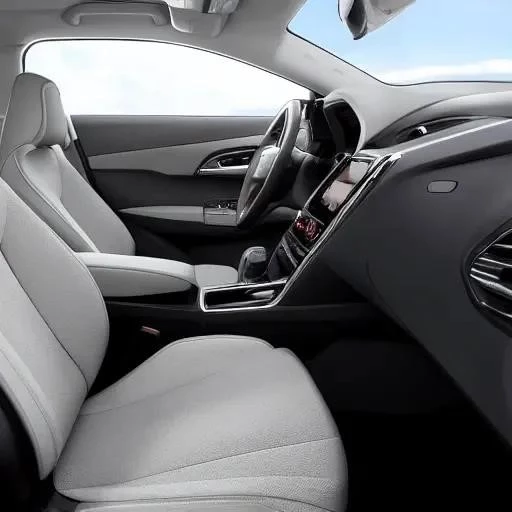
In an automotive landscape perpetually evolving, a remarkable revolution is quietly transforming the very heart of our driving experience: the car interior. For too long, discerning drivers believed that truly luxurious, technologically advanced, and exquisitely crafted cabins were exclusively reserved for vehicles commanding stratospheric price tags. That era, however, has definitively concluded. As we navigate the dynamic year of 2025, an exciting paradigm shift is empowering consumers to discover unparalleled comfort and sophisticated design without exceeding a $50,000 budget, proving that premium doesn’t always equate to exorbitant.
Today, shrewd engineering and intense market competition have converged, creating an unprecedented opportunity for buyers. Manufacturers are no longer merely competing on performance or exterior aesthetics; they are fiercely battling for supremacy within the confines of the cabin itself. This intense rivalry has democratized features once considered elite, bringing sumptuous materials, cutting-edge infotainment, and meticulously designed ergonomics within reach of the everyday motorist. It’s a testament to innovation, demonstrating that a truly exceptional driving environment is now an attainable reality, promising an elevated sense of well-being on every journey.
| Model | Key Interior Features | Why It Stands Out |
|---|---|---|
| 2025 Genesis G70 | Premium Nappa leather, intricate stitching, driver-centric cockpit, advanced infotainment, customizable ambient lighting. | Often mistaken for a far more expensive luxury sedan, it masterfully blends sportiness with opulent comfort and cutting-edge technology. |
| 2025 Hyundai Santa Fe | Impressively spacious cabin, dual 12.3-inch displays, thoughtful use of sustainable materials, versatile cargo space, unique utility features. | A remarkable transformation for the segment, offering a rugged yet refined interior perfect for families seeking both adventure and unexpected comfort. |
| 2025 Kia K4 | Bold, avant-garde design, seamless connectivity with a panoramic display, intuitive haptic controls, surprisingly upscale materials for its class. | Challenging traditional compact sedan norms, the K4 presents a stylish and tech-forward interior that punches significantly above its weight class. |
| 2025 Lincoln Corsair | “Whisper Quiet” cabin, available Perfect Position seats with invigorating massage functions, immersive Revel audio, elegant material choices, panoramic vista roof. | A true sanctuary on wheels, focusing intently on serene comfort and a distinctly American luxury experience, consistently surpassing expectations. |
| Volvo S90 | Minimalist Scandinavian design ethos, genuine open-pore wood and real metal accents, ergonomically perfect seating, advanced air purification, available massaging seats. | Exemplifies understated elegance and holistic well-being, prioritizing occupant comfort, intuitive functionality, and a tranquil atmosphere over ostentation. |
For an in-depth analysis and further reviews of these and other top contenders, visit Autotrader’s 10 Best Interiors Under $50,000 for 2025.
The journey towards an elevated interior experience begins with a radical shift in material selection. Gone are the days when interiors under $50,000 were synonymous with hard plastics and generic fabrics. Today’s leading models, such as the 2025 Genesis G70 and the Lincoln Corsair, are confidently integrating soft-touch surfaces, sophisticated simulated leathers, and even genuine wood or metal accents. “This isn’t just about aesthetics; it’s about the tactile experience,” explains a leading automotive interior designer, emphasizing the profound psychological impact of premium materials. “Every touchpoint, from the steering wheel to the door panels, now conveys a sense of quality and thoughtful craftsmanship, making daily commutes feel incredibly special.”
Beyond luxurious textures, technology has become an undeniable cornerstone of the modern car interior. The seamless integration of digital displays, intuitive infotainment systems, and advanced driver-assistance features transforms the cabin into a high-tech command center. Vehicles like the 2025 Hyundai Santa Fe, with its dual 12.3-inch panoramic displays, exemplify this trend, offering crystal-clear graphics and fluid user interfaces that rival systems found in vehicles twice their price. By integrating insights from AI-driven user experience research, manufacturers are crafting systems that are not only powerful but also remarkably easy to navigate, minimizing distraction and maximizing engagement. Imagine controlling your navigation, entertainment, and climate with a mere gesture or voice command, all within a beautifully rendered digital ecosystem.
However, true luxury extends far beyond visible materials and dazzling screens; it encompasses the intangible essence of comfort and well-being. Ergonomics, seat design, and acoustic isolation are now receiving unprecedented attention. The Volvo S90, for instance, has long been lauded for its supremely comfortable, orthopedically designed seats and its commitment to a “whisper quiet” cabin, effectively transforming the car into a personal sanctuary from the cacophony of the outside world. This holistic approach to interior design means paying meticulous attention to details like superior sound deadening, multi-zone climate control, and even advanced air filtration systems, creating an environment that actively promotes relaxation and reduces driver fatigue, even on the longest journeys.
Looking ahead, the future of affordable luxury interiors promises even more astonishing advancements. Industry experts predict a surge in sustainable and recycled materials, offering both an opulent feel and an eco-conscious appeal. Personalization will also reach new heights, with customizable ambient lighting, modular interior layouts, and AI-powered systems that learn and adapt to individual driver preferences. The competition among brands like Kia, Hyundai, and Genesis is only intensifying, driving innovation at a furious pace and ensuring that the benchmark for “affordable luxury” continues to climb. This exciting evolution confirms that your next vehicle, even under the $50,000 mark, can and will offer an interior experience that is nothing short of extraordinary.
